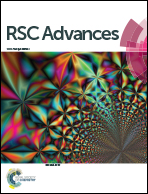Highly sensitive turn-off fluorescent detection of cyanide in aqueous medium using dicyanovinyl-substituted phenanthridine fluorophore†
Abstract
Herein, the turn-off fluorescence sensor of 2-((4′-(7,8,13,14-tetrahydrodibenzo[a,i]phenanthridin-5-yl)-[1,1′-biphenyl]-4-yl)methylene)malanonitrile (7) was developed for the recognition of CN− ions and studied using different spectroscopic techniques. The selective recognition of CN− ions by 7 was investigated via UV-vis spectroscopy and fluorescence studies in acetonitrile solvent, which exhibited an obvious color change from orange to colorless under 365 UV light. The sensor compound 7 possesses a high binding constant (Ka) for CN− ions in the order of 5.22 × 106 M−1. The results from the interference studies revealed that probe 7 shows high sensing selectivity and sensitivity for CN− ions over other competitive anions. Probe 7 interacts with cyanide to form a 1 : 1 adduct, and this mechanism was further verified by 1H NMR titration, Job's plot analyses and DFT studies. The sensor probe 7 exhibits advantages such as low limit of detection (LOD) of 39.3 nM, fast response and sensing in a wide pH range of 3 to 11. The practical application of 7 was successfully demonstrated for the determination of CN− ions in test paper strips and various water samples.



 Please wait while we load your content...
Please wait while we load your content...